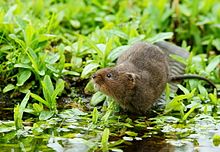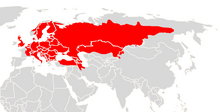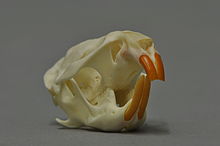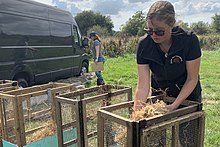European water vole
| European water vole | |
|---|---|

| |
| Scientific classification | |
| Domain: | Eukaryota |
| Kingdom: | Animalia |
| Phylum: | Chordata |
| Class: | Mammalia |
| Order: | Rodentia |
| Family: | Cricetidae |
| Subfamily: | Arvicolinae |
| Genus: | Arvicola |
| Species: | A. amphibius
|
| Binomial name | |
| Arvicola amphibius | |

| |
| Synonyms | |
|
Arvicola terrestris(Linnaeus, 1758) | |
TheEuropean water vole(Arvicola amphibius) ornorthern water vole,is asemi-aquaticrodent.It is often informally called thewater rat,though it only superficially resembles a truerat.[3]Water voles have rounder noses than rats, deep brown fur, chubby faces and short fuzzy ears; unlike rats their tails, paws and ears are covered with hair.
In the wild, on average, water voles only live about five months. Maximum longevity in captivity is two and a half years.[4]
Appearance
[edit]
Water voles reach 14–22 centimetres (5.5–8.7 in) in length, plus a tail which is about half the length of the body. Weights reported for adults are variable. It is possible for large, optimal adults to weigh as much as 225 to 386 g (7.9 to 13.6 oz)[5]However, these are peak weights. Elsewhere, the mean body mass has been reported as 60 to 140 g (2.1 to 4.9 oz), although this figure includes immature water voles.[6]The minimum weight to successfully breed as well as to survive winter is reportedly 112 g (4.0 oz) in females and 115 g (4.1 oz) in males.[7]As a species the mean body mass is claimed as 140 g (4.9 oz).[8]
Overall, European water voles are a uniform dark brown colour, with slightly paler coloration on the underside. Their pelage is quite thick and they are furred over their entire body, including their tail, unlikerats.Their dark colour allows them to blend in well in the densely vegetated areas they inhabit.[9]
Taxonomy
[edit]The binomial applied to the European water vole isArvicola amphibius;it was formerly known by thejunior synonymA. terrestris.The confusion stems from the fact thatLinnaeusdescribed two species of water vole on the same page of the same work. Those two forms are now universally considered the same species. It has been recognized asA. amphibius(Linnaeus, 1758) because the first source to unite the two forms, which Linnaeus had treated separately, into a single species choseA. amphibiusas the valid name.[2]The species is widely known by the synonymA. terrestris,which for many decades was treated as the valid name.
Some authorities consider thesouthwestern water vole(Arvicola sapidus) to be the same species, but it is now generally considered distinct.[1][10]
Range
[edit]The European water vole (Arvicola amphibius) is found in most of Europe, Russia, West Asia and Kazakhstan.[1]
Habitat
[edit]
In Britain, water voles live in burrows excavated within the banks of rivers, ditches, ponds, and streams. Burrows are normally located adjacent to slow moving, calm water which they seem to prefer. They also live in reed beds where they will weave ball-shaped nests above ground if no suitable banks exist in which to burrow.
Water voles prefer lushriparianvegetation which provides important cover to conceal animals when they are above ground adjacent to the water body. Areas of heavily grazed and trampled riparian habitats are generally avoided.[11]Water voles may be displaced by the introduction of riparian woodland and scrub as they prefer more open wetland habitats away from tree cover.
As well as frequenting typical lowland wetland habitats dominated by rank marginal aquatic vegetation, water voles are also just as at home in areas upland 'peatland' vegetation where they utilize suitable small ditches, rivers, and lochs surrounded by moorland up to 1,000 m asl (e.g., northern Scotland).[12]
In Europe and Russia, they may venture into woods, fields, and gardens. They live under the snow during the winter.
Water voles are currently being reintroduced as a threatened species in Yorkshire, England. In the Massif Central area of France, however, farmers are campaigning for action to be taken against water voles, where plagues of these rodents are causing major damage to crops.[citation needed]
Diet
[edit]Water voles mainly eat grass and other vegetation near the water, but will also consume fruits,bulbs,twigs,buds,and roots when given the opportunity. In Europe, rich harvest periods can cause water vole "plagues" to take place, during which the voles eat ravenously, destroying entire fields of grass and leaving the fields full of burrows. Water voles in some parts of England have been shown to occasionally prey on frogs and tadpoles; it has been speculated that this is to make up for a protein deficiency in the voles' diet.[13]
Food remains alone are not a reliable indicator of the presence of this species, as other smaller voles can also leave remains of large grasses and rushes.[14]
Breeding
[edit]The mating period lasts from March into late autumn. The female vole'spregnancylasts for approximately 21 days. Up to 8 baby voles can be born, each weighing around 10 grams (0.4 oz). The young voles open their eyes three days after their birth. They are half the size of a full grown water vole by the time they are weaned.
Behaviour
[edit]Water voles are expert swimmers and divers. They do not usually live in large groups. Adult water voles each have their own territory, which they mark with fecal latrines located either near the nest or burrow, or at favoured water's edge platforms where voles leave or enter the water.[12]Latrines are known to be a good survey indicator of this species, and can be used to gauge abundance of animals.[15]They also scent-mark by using asecretionfrom their bodies (a flank gland), although this is not normally detectable during a field survey. They may attack if their territory is invaded by another water vole.
Predation
[edit]As a large and common microtine rodent, the range of predators faced by the European water vole is extensive. However, many species of predator prefer otherrodents,such asMicrotusvolesandwood mice,due to their greater numerical abundance.[7]Wildcats,red foxes,most species ofhawk(especiallycommon buzzards),owl(especially thebarn owl,genusStrix,andEurasian eagle-owl) andfalcon(in large numbers by thecommon kestrel) in their range are among their reported predators. A very large number are also taken bymustelids.Reportedly smallMustelaweasels as well asEuropeanand introducedAmerican minkmay take the largest number of water voles of any predator due in part to aligning habitat preferences.[7][16]The rarely checked invasive population of American mink has reportedly caused a decline of water voles inBritain.[17]
Conservation
[edit]United Kingdom
[edit]
On 26 February 2008, the U.K. Government announced full legal protection for water voles would be introduced from 6 April 2008.[18]
Water voles have recently returned toLindow Commonnature reserve in Cheshire, after many years of absence.[19]
In 2015,People's Trust for Endangered Specieslaunched a new project to try to coordinate conservation efforts for the water-vole in the U.K. The National Water-Vole Monitoring Programme (NWVMP) is the first ongoing monitoring scheme for this species in the U.K. and aims to bring together data from several hundred sites to allow the status of this animal to be assessed year-on-year.[20] In September 2019, theBox Moor Trustre-introduced 177 water voles in to theRiver BulbourneinHemel Hempsteadas part of a three-year plan.[21]
Literary appearances
[edit]A water vole named "Ratty" is a leading character in the 1908 children's bookThe Wind in the WillowsbyKenneth Grahame:the locality used in the book is believed to beMoor CopseinBerkshire,Englandand the character's name "Ratty" has become widely associated with the species and their riverbank habitat, as well as the misconception that they are a species of rat.[22][23]
In the comic novel and filmCold Comfort FarmbyStella Gibbons,one of the characters, Urk, refers to the subject of his unrequited love, Elfine Starkadder, as his little water-vole. Throughout the story, Urk spends a lot of time talking to the water-voles on the farm.
C. S. Calverleya 19th-century writer of (among other things) light verse, in his poem "Shelter", beginning:
By the wide lake's margin I mark'd her lie—
The wide, weird lake where the alders sigh—
Tells of an apparently shy, easily frightened young female by a lakeside, who in the last line of the poem, it is revealed that:
For she was a water-rat.
TheRolling Stonessong "Live With Me" includes the line "My best friend he shoots water rats and feeds them to his geese", referring toKeith Richards'shabit of shooting water voles in the moat of hisRedlands, West Witteringhome.[24]
References
[edit]- ^abcBatsaikhan, N.; Henttonen, H.; Meinig, H.; Shenbrot, G.; Bukhnikashvili, A.; Hutterer, R.; Kryštufek, B.; Yigit, N.; Mitsain, G.; Palomo, L. (2021) [amended version of 2016 assessment]."Arvicola amphibius".IUCN Red List of Threatened Species.2021:e.T2149A197271401.doi:10.2305/IUCN.UK.2021-1.RLTS.T2149A197271401.en.Retrieved17 February2022.
- ^abMusser, G.G.;Carleton, M.D. (2005)."Superfamily Muroidea".InWilson, D.E.;Reeder, D.M (eds.).Mammal Species of the World: A Taxonomic and Geographic Reference(3rd ed.). Johns Hopkins University Press. pp. 894–1531.ISBN978-0-8018-8221-0.OCLC62265494.
- ^Freeston, H. (1997)."Tales of the Riverbank—How to spot 'Ratty' (previously" Water Volewatch 97 ")".Lincolnshire Wildlife Trust.Archived fromthe originalon September 25, 2006.Retrieved2006-08-23.
- ^"The Mammal Society".Mammal.org.uk.Retrieved2013-02-26.
- ^Forder, V."Ecology and Conservation of the Water Vole Arvicola terrestris amphibius"(PDF).Wildwood Trust. Archived fromthe original(PDF)on 2016-03-03.Retrieved2015-02-12.
- ^Saucy, F. (1994).Density dependence in time series of the fossorial form of the water vole, Arvicola terrestris.Oikos, 381-392.
- ^abcYavuz, Güliz, Ercüment Çolak, and Teoman Kankılıç.Investigations on the Ecology of Eurasian Water Vole, Arvicola amphibius (Rodentia: Mammalia) in Ankara Province.Pakistan Journal of Zoology 45.6 (2013): 1599-1605.
- ^Morand, S., & Poulin, R. (1998). Density, body mass and parasite species richness of terrestrial mammals. Evolutionary Ecology, 12(6), 717-727.
- ^Niethammer, J. 1990.Water Voles (Genus *Arvicola*).Pp. 242-245 in S Parker, ed. Grzimek's Encyclopedia of Mammals, Volume III. NY: McGraw-Hill Publishing Company.
- ^Rigaux, P.; Vaslin, M.; Noblet, J.F.; Amori, G.; Palomo, L.J. (2008)."Arvicola sapidus".IUCN Red List of Threatened Species.2008:e.T2150A9290712.doi:10.2305/IUCN.UK.2008.RLTS.T2150A9290712.en.Retrieved11 November2021.
- ^Strachan, R. and Moorhouse, T. (2006).Water Vole Conservation Handbook(2nd edition). Wildlife Conservation Research Unit, University of Oxford.
- ^abHarris, S. and Yalden, D.W. (2008).Mammals of the British Isles: Handbook,4th Edition. The Mammal Society.
- ^"Water voles get a taste for frogs".BBC News.30 April 2010.
- ^Ryland, K. and Kemp, B (2009). "Using field signs to identify water voles - are we getting it wrong?",In Practice, Bulletin of the Institute of Ecology and Environmental Management.63,March 2009 (pp. 23-25).
- ^Strachan, R. and Moorhouse, T. (2006). Water Vole Conservation Handbook (2nd edition). Wildlife Conservation Research Unit,University of Oxford.
- ^Macdonald, D. W., Sidorovich, V. E., Anisomova, E. I., Sidorovich, N. V., & Johnson, P. J. (2002).The impact of American mink Mustela vison and European mink Mustela lutreola on water voles Arvicola terrestris in Belarus.Ecography, 25(3), 295-302.
- ^Jefferies, D. J., Morris, P. A., & Mulleneux, J. E. (1989).An enquiry into the changing status of the water vole Arvicola terrestris in Britain.Mammal Review, 19(3), 111-131.
- ^"Press release on Government news network".26 February 2008.[permanent dead link]
- ^Macclesfield Borough Council's "Countryside and Ranger Service"."News from Lindow".Archived fromthe originalon 2007-01-18.Retrieved2006-08-23.
- ^"PTES website for the National Water Vole Monitoring Programme".PTES.Retrieved2015-05-09.
- ^"Ratty returns to Hemel Hempstead!".The Box Moor Trust. 2019.RetrievedSeptember 6,2019.
- ^"RSPB".RSPB.Retrieved2013-02-26.
- ^Water Voles: The Return of Ratty (2009-01-21)."BBC Devon".Bbc.co.uk.Retrieved2013-02-26.
- ^"The Rolling Stones - Live With Me (Official Lyric Video)".ABKCOVEVO. 31 October 2019.Retrieved10 February2023.
External links
[edit]- General information on Water Voles(Archived; <2011)
- Bray, G. (2020)."European water vole guide: identification, diet and habitat".DiscoverWildlife (BBC).Archivedfrom the original on 2021-06-27.Retrieved2021-06-27.

